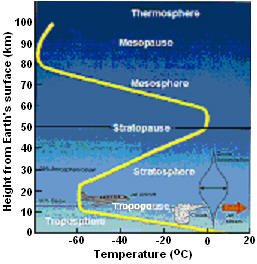Atmospheric Circulation and Weather

|
Atmospheric Circulation and Weather |
 |
|
|
|
|
El Niño etc.
Abrupt Climate Change:
|
||||||||||||||||||||||
|
|
|||||||||||||||||||||||
| Ocean-atmosphere interactions |
|
|
|
|
||||||||||||
 |
|||||||||||||
|
|
||
Ocean-atmosphere interactions (a) moderate surface temperatures, (b) shape the earth’s overall weather and climate, and
|
(c) create ocean waves and currents. l Atmosphere is the solid earth’s ~110 km thick gaseous envelope; weather is the atmosphere’s state at a given point in time and space; and climate is the weather’s yearly averaged seasonal composite. l In the near-surface region that we are interested in, i.e., the troposphere (it extends to 10-15 km above earth’s surface and carries ~90% of the atmospheric mass), average temperatures decrease as we go up. l The atmosphere — is uniquely rich in N2 (78%) and O2 (21%) - Moon and Mars lack an atmosphere, atmosphere of Venus is CO2-rich (~96%), while Jupiter and Saturn have H and He dominated atmospheres; — evolved in three phases: (1) H, He rich early phase of ~4.5 Ga ago, (2) |
|
|
|||
|
CO2, N2 and H2O rich middle phase of ~3.7 Ga ago and (3) N2 and O2 rich present phase since ~1.25 Ga ago. |
|
||||
|
l Where did Earth’s CO2 go? |
― Atmosphere has ~0.03% CO2, Seawater ~60 times as much. ― Carbonates (e.g., limestones) precipitate in the ocean bottom. Indeed, most of this C is now locked up in limestones and marble. |
|
|||
|
Oceans have thus depleted the earth’s atmosphere of its CO2 content. l Three forces mainly drive atmospheric circulation: (a) differential solar heating of earth’s surface, (b) gravity, i.e., equatorial bulge versus polar flattening, and (c) rotation. l As solar heating of the earth’s surface varies with latitude, — earth’s elliptical orbit and 23½° tilt of spin axis create seasons; and |
|
|
|||
|
― evaporation dominates radiation in the tropics while water freezes at the polar latitudes to create icecaps. |
|
||||
|
l Moisture–laden warm air that rises at the equator cools down and must sink but (a) travels polewards as gravity at the poles exceeds that at equator and (b) begins equatorward return as cold surface air after sinking at the pole, so creating a convective cell. l Being basically unstable, this single cell breaks down into three, at 30° and 60° (N and S) latitudes. This creates (a) high pressure zones of sinking air masses at the 30 N and S latitudes and poles (these latitudes thus have deserts on land and high surface water salinity in the oceans), and (b) low pressure zones of rising air masses at the 60 N and S latitudes and equator (these latitudes thus have rain forests on land and low surface water salinity in the oceans). |
|
|
|||
|
|
l The Coriolis deflection of these convection cells in the direction of Earth’s spin now creates: |
|
|||
|
― westward surface winds (“trade winds”) at 0°-30°N and 0°-30°S, ― eastward surface winds (“prevailing westerlies”) at 30°-60°N & S, and ― westward surface winds (“polar easterlies”) at 60°-90°N and S. |
|||||
|
l Equatorial surface air thus flows against earth’s spin direction. Warm surface waters thus stack up on the western margins of tropical/semi-tropical oceans, with the following results: ― Warm surface waters stack up on the western margins of tropical/semitropical oceans. This (a) deepens the thermocline on the western coasts, so producing generally humid climatic conditions on one hand and poor fishing conditions on the other; and (b) creates breeding grounds for tropical storms/cyclones on these western margins. ― Upwelling of cold deep waters on the opposite eastern coasts produces arid climates on one hand but excellent fishing on the other. |
|
||||
|
|||||||||||||||
|
Where did Earth’s CO2 go? |
■ |
Atmosphere has ~0.035% CO2, oceans ~60 times as much. |
|||||||||||||
|
|
■ | Carbonates (e.g., limestones) precipitate in the ocean bottom. Indeed, most of this C is now locked up in limestones and marble. | |||||||||||||
|
Oceans have thus depleted the earth’s atmosphere of its CO2 content. |
|||||||||||||||
|
|||||||||||||||
|
|||||||||||||||
|
|
|||||||||||||||
|
|||||||||||||||
|
|||||||||||||||